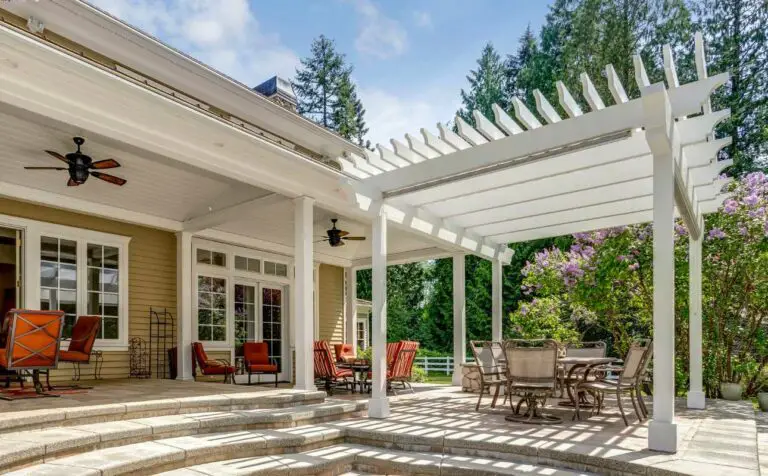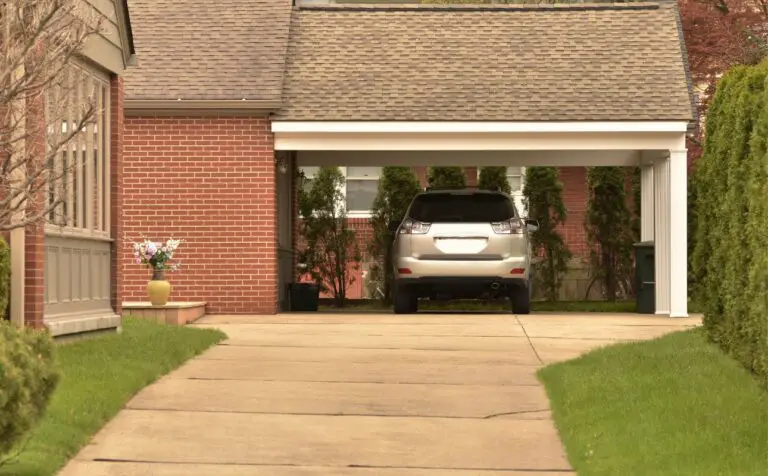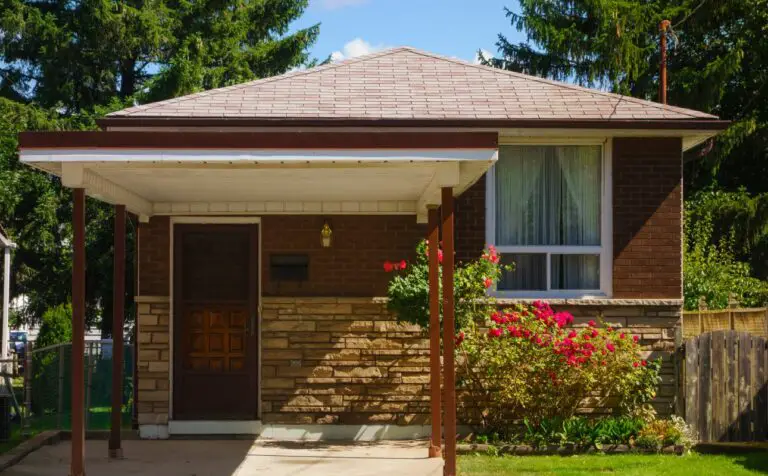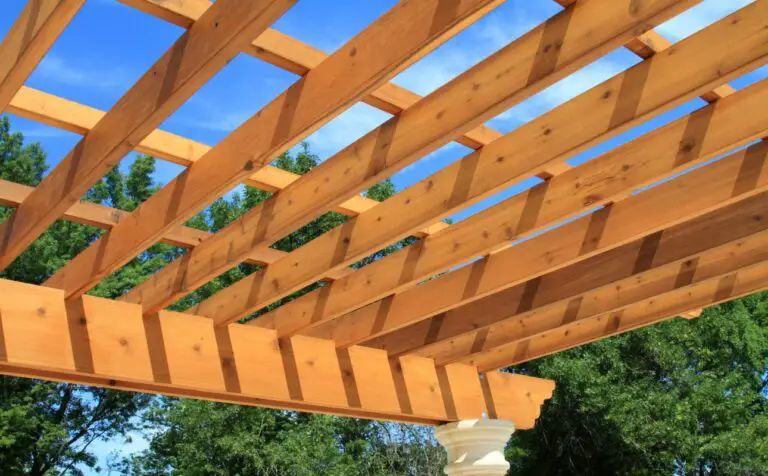How Long Do Carports Last? (Here’s What to Expect)
Carports are like the unsung heroes of our homes. They stand tall and strong, shielding our beloved vehicles from the wrath of Mother Nature.
But have you ever wondered how long these structures can withstand the test of time? In general, a well-made portable carport can have a lifespan of approximately ten to twenty years.
It’s important to note that cheaper options may experience wear and tear on the fabric covering in a shorter period. Generally, the steel frame of the carport will outlast the outer fabric material.
If the carport utilizes UV-treated polyethylene fabric, it can have a longer lifespan due to its resistance to sun damage and degradation.
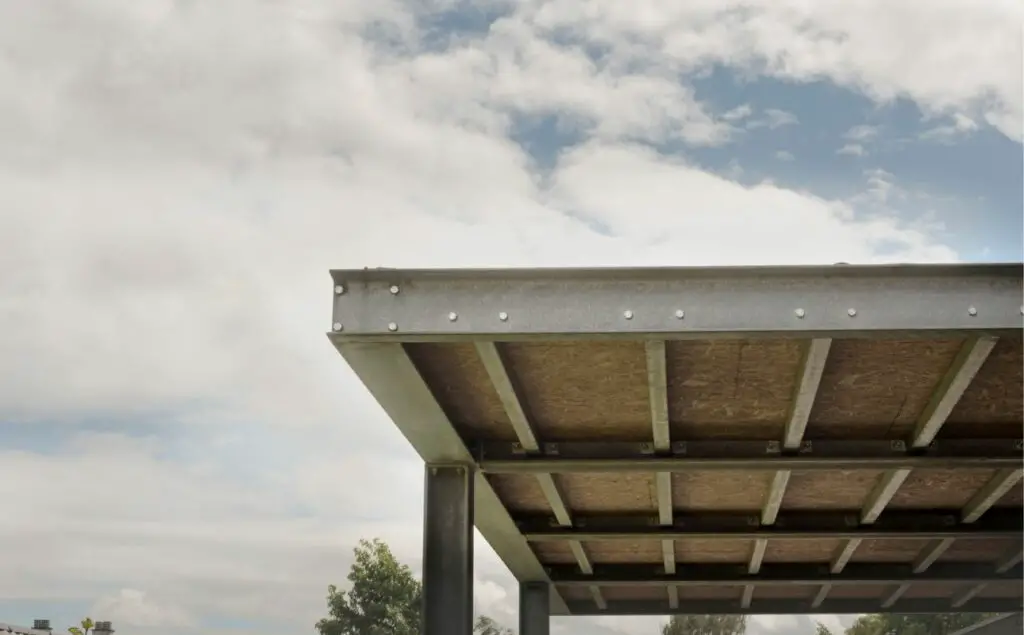
Quality of Materials
The durability and longevity of carports are significantly influenced by the quality of materials utilized in their construction. The materials used should be carefully selected to ensure that they have a high level of impact resistance and can withstand extreme weather conditions.
Durability of construction is also an essential factor to consider when selecting materials for your carport, as it will determine how long the structure will last without requiring constant repairs or maintenance.
Using high-quality materials such as steel, aluminum, or wood with protective coatings can extend the life span of your carport significantly.
Installation Process
Through careful planning, precise measurements, and skillful execution, the process of installing a carport can ensure structural stability and durability.
While cost comparison may lead some to consider DIY options for installation, it is important to note that improper installation can compromise the longevity of the carport.
- The first step in the installation process involves preparing the site by ensuring a level surface and proper drainage.
- Next, anchoring systems must be securely installed to prevent movement or collapse during inclement weather conditions.
- Finally, attention must be paid to properly attaching roofing materials to prevent leaks and damage from wind or heavy precipitation.
Maintenance and Repairs
When it comes to maintaining carports, there are several common tasks that should be performed regularly. These include:
- Cleaning the structure to remove debris and dirt buildup
- Inspecting for any signs of damage or wear
- Tightening any loose bolts or screws
Some signs that repairs may be needed include:
- Rusted metal parts
- Cracked foundations
- Warped or sagging roofing materials.
Common maintenance tasks for carports
Regular maintenance tasks, such as cleaning and inspecting for damage, can help prolong the lifespan of carports and ensure they remain structurally sound.
A cleaning schedule should be established to remove dirt, debris, and other materials that may accumulate on the surface of the carport. This is particularly important in areas with high levels of pollution or where trees are present.
Rust prevention techniques should also be employed to prevent corrosion from developing on metal components.
Inspecting for damage should involve checking for cracks or other signs of wear and tear on the roof panels, support beams, and fasteners. Additionally, any loose bolts or screws should be tightened immediately to prevent further damage from occurring.
Signs that repairs may be needed
Ensuring the safety and protection of vehicles and belongings is crucial, therefore recognizing signs of damage and addressing necessary repairs promptly can prevent costly consequences.
Rust prevention should be a top priority for carport owners as it can significantly compromise the structural integrity of the carport. Signs of rust include discoloration, flaking or bubbling paint, and visibly corroded metal.
In addition to rust prevention, it is important to inspect for any structural damage such as bent or warped beams, loose connections, or cracks in concrete footings. These issues not only affect the stability of the carport but also pose a safety hazard to anyone underneath it.
Environmental Factors
Environmental factors play a significant role in the durability of carports, as exposure to harsh weather conditions such as extreme heat, heavy rainfall, and strong winds can accelerate wear and tear on the structure, potentially reducing its lifespan by several years.
Weathering effects, especially in geographic locations that experience long periods of intense sunlight or high levels of precipitation, can cause rust and corrosion to develop on metal components.
Additionally, wooden carports are vulnerable to rotting due to moisture accumulation from rain and snow. The impact of wind loads can also cause structural damage or even lead to collapse if the carport is not properly anchored.
Expected Lifespan
Carport durability can vary greatly depending on the quality and type of material used. For example, a steel or aluminum carport may last longer than one made from wood or plastic.
In addition, regular maintenance such as cleaning and painting can extend the life of a carport. Exposure to environmental stressors such as extreme weather conditions and natural disasters can also impact the lifespan of a carport.
Depending on these factors, replacement frequency for a carport could range anywhere from 10-20 years or more.
Can a carport be converted into a garage in the future?
A carport can potentially be converted into a garage in the future. The conversion process involves enclosing the sides of the carport, adding walls, doors, and potentially making modifications to the roof.
The feasibility of conversion depends on factors such as the existing structure, local building codes, and your specific needs. Converting a carport into a garage may require professional assistance, including obtaining permits and ensuring compliance with building regulations.
It’s advisable to consult with a contractor or local authorities to assess the viability of the conversion and ensure the project is carried out safely and in accordance with applicable regulations.
How do carports compare to other types of outdoor shelters, such as pergolas or awnings?
When comparing carports to other types of outdoor shelter like pergolas or awnings, there are several key differences to consider:
Purpose and Function:
- Carports: Carports are specifically designed to provide shelter for vehicles. They offer protection from the elements such as sun, rain, and snow, keeping vehicles covered and reducing their exposure to environmental factors.
- Pergolas: Pergolas are outdoor structures with open roofs and supporting columns. They are primarily used for creating shaded areas in gardens or outdoor spaces. Pergolas often serve as decorative features and provide partial shade without complete weather protection.
- Awnings: Awnings are typically attached to the exterior of a building and extend over windows, doors, or patios. They offer shade and protection from the sun or light rain, primarily focusing on creating shaded areas for outdoor relaxation or entertainment.
Coverage and Protection:
- Carports: Carports provide full coverage and protection for vehicles. They have a roof and, depending on the design, may have open sides or partial enclosures.
- Pergolas: Pergolas have an open roof structure that provides partial shade but does not offer complete protection from rain or intense sun exposure.
- Awnings: Awnings provide shade and limited protection from light rain, but they do not provide full coverage or protection from all weather conditions.
Structural Design:
- Carports: Carports are typically designed with sturdy materials like steel, aluminum, or wood. They have a more robust structure to support the weight of the roof and withstand various weather conditions.
- Pergolas: Pergolas often feature wooden or metal frames with open rafters or cross beams. They have a more decorative and visually appealing design, focusing on creating a pleasant outdoor space.
- Awnings: Awnings consist of a fabric or metal cover supported by a frame. They are generally lightweight and designed to be retractable or adjustable for flexible usage.
Flexibility and Customization:
- Carports: Carports can be customized to accommodate various vehicle sizes and may include additional features like storage areas or extra space for outdoor activities.
- Pergolas: Pergolas offer flexibility in terms of design, size, and customization options. They can be tailored to match different architectural styles and can incorporate features like climbing plants, curtains, or lighting for added aesthetics.
- Awnings: Awnings come in different sizes, styles, and fabric options. They can be manually or electronically retractable, allowing for adjustment based on changing weather conditions.
Cost:
- Carports: Carports are generally more expensive than pergolas or awnings due to their larger size and more robust structure, especially if they are enclosed or have additional features.
- Pergolas: Pergolas have a wide range of pricing depending on the materials used, size, and design complexity. They can be more affordable compared to carports, especially if they are made from simple materials.
- Awnings: Awnings vary in cost depending on the size, materials, and type (retractable or fixed). They are often more affordable than carports or pergolas.
The Bottom Line
Considering all these factors, it’s safe to say that a well-built carport can last between 20-30 years or more if properly maintained over time. However, several variables will determine how long your specific structure will last; therefore, it’s essential to seek expert advice when installing or repairing your carport.
Ultimately how you treat your carport plays an integral role in determining its longevity; so ensure proper maintenance practices are followed consistently throughout its life cycle for maximum performance! Will you take care of your investment?
FAQ
Are carports more durable than traditional garages?
No, traditional garages are generally considered more durable than carports. Traditional garages are typically built with solid walls, a roof, and secure doors, providing better protection and structural integrity.
Carports, while providing shelter for vehicles, often have open sides and less robust construction, making them generally less durable than enclosed garages. However, the durability of both carports and garages can vary depending on factors such as materials used, construction quality, and maintenance practices.
Can carports be customized to fit unique vehicle sizes?
Custom carport designs offer flexibility in accommodating unique vehicle sizes. However, carport size limitations may affect the customization options available for some vehicles.
Carports are typically designed to fit standard-sized vehicles, but modifications can be made to accommodate larger or smaller vehicles. The customization process involves careful planning and consideration of factors such as the dimensions of the vehicle, height restrictions, local building codes, and wind and snow loads.
What is the average cost of a carport and is it worth the investment?
The average cost of installing a carport ranges from $1,000-$5,000 depending on the materials used and size of the structure.
Despite this investment, the long-term benefits make it worth considering for those who prioritize protecting their vehicles without breaking the bank.
The installation process is relatively straightforward but requires some technical knowledge and may require professional help for more complicated structures.
